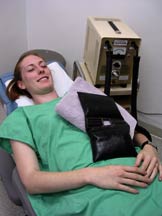Diathermy
 Diathermy is a very effective electronic therapy which enhances the body's ability to heal. The primary effects of diathermy are produced by the heating of the tissue. The advantage of diathermy (as compared to heating pads, heat lamps or hot baths) is that it reaches deep into the internal tissues of the body to increase the circulation. Other heating methods penetrate approximately 2 mm; diathermy penetrates 6 inches to 8 inches, and in the process increases circulation in the affected part. The main effect of the heat is an increase in blood flow and sedation of the sensory and motor nerves and an increase in the secretion of the glandular organs. Therefore, it is quite effective in relieving pain and muscle spasm. The increase in circulation results in dilation of the capillaries, arteries and lymph vessels; increase in the alkaline blood supply, resulting in a reduction in the tissue acidity and thus relief of pain and irritation.; increased flow of leukocytes and leukocyte infiltration; increased phagocytosis; production of a generalized fever; destruction of heat sensitive microbes.
Diathermy is a very effective electronic therapy which enhances the body's ability to heal. The primary effects of diathermy are produced by the heating of the tissue. The advantage of diathermy (as compared to heating pads, heat lamps or hot baths) is that it reaches deep into the internal tissues of the body to increase the circulation. Other heating methods penetrate approximately 2 mm; diathermy penetrates 6 inches to 8 inches, and in the process increases circulation in the affected part. The main effect of the heat is an increase in blood flow and sedation of the sensory and motor nerves and an increase in the secretion of the glandular organs. Therefore, it is quite effective in relieving pain and muscle spasm. The increase in circulation results in dilation of the capillaries, arteries and lymph vessels; increase in the alkaline blood supply, resulting in a reduction in the tissue acidity and thus relief of pain and irritation.; increased flow of leukocytes and leukocyte infiltration; increased phagocytosis; production of a generalized fever; destruction of heat sensitive microbes.In summary, diathermy optimizes the body's own immune response and relieves inflammation and pain.
Interestingly, on average, the internal body temperature rises approximately one degree Fahrenheit for each 15 minutes of diathermy. In patients with reduced metabolic rate and/or subnormal temperature, long heating times increase the internal temperature of the body and, again, improve the immune response. There is evidence that these improvements are relatively long lasting after the conclusion of the therapy.
Some of the conditions that are accessible to treatment with diathermy include: a wide variety of urinary tract problems (since treatment with diathermy will double or triple urinary excretion), muscle spasm, pneumonia, liver problems, adrenal insufficiency, otitis media, low back pain, headaches, venous stasis ulcers, chronic inflammatory and congestive conditions, chronic inflammation of the abdominal organs (such as gallbladder and its ducts, peritoneal adhesions, intestinal spasm), pleurisy, bronchial asthma and bronchitis, neuralgia and myalgia in the subacute and chronic stage, and organic nervous disorders such as general paralysis. At the RFHC we also use diathermy after breaking down internal adhesions with cross-fiber work.
In practice at the RFHC, we have observed that particularly in cases of viral pneumonia, diathermy combined with appropriate Chinese herbs, results in much quicker recovery times than simple medical therapy. Even in cases of bacterial pneumonia where antibiotics are indicated, the antibiotics work much more quickly and the person recovers much faster given regular diathermy treatments to speed the process. We also use diathermy extensively with people who have chronic fatigue syndrome. Diathermy to the adrenals increases organ function and improves the overall stamina and strength. In patients with allergies, liver diathermy will often discharge the inflammatory byproducts of the allergy reaction and allow people to recover much more quickly from a toxic situation.
Overall, diathermy is one of the most helpful modalities in use at the RFHC.
Contraindications
Diathermy is not to be used in cases of malignancy, where hemorrhage is a possibility (i.e., during menses) and in cases of oozing pus.
Does this seem helpful? If so, see our information on Consultations.
[TOP]
© 2013, Dr N Rowan Richards. This site or any part may not be reproduced without the written consent of Richards Family Health Center. N Rowan Richards, DC, DABCI, FIACA at 727 Lee Court, Twin Falls ID 83301. 626.303.3162. email:frontoffice@richardsfamilyhealth.com. This site is Not intended to dispense health advice or serve as a substitute for actual patient contact with a qualified healthcare provider. Our sole purpose is one of education. It is our expectation that our site can educate our visitors about the efficacy of some healthcare treatments that exist as an alternative to conventional medical wisdom.
PRIVACY POLICY: Richards Family Health Center takes your privacy very seriously. Be assured that we do not sell or rent your contact information to anyone.


